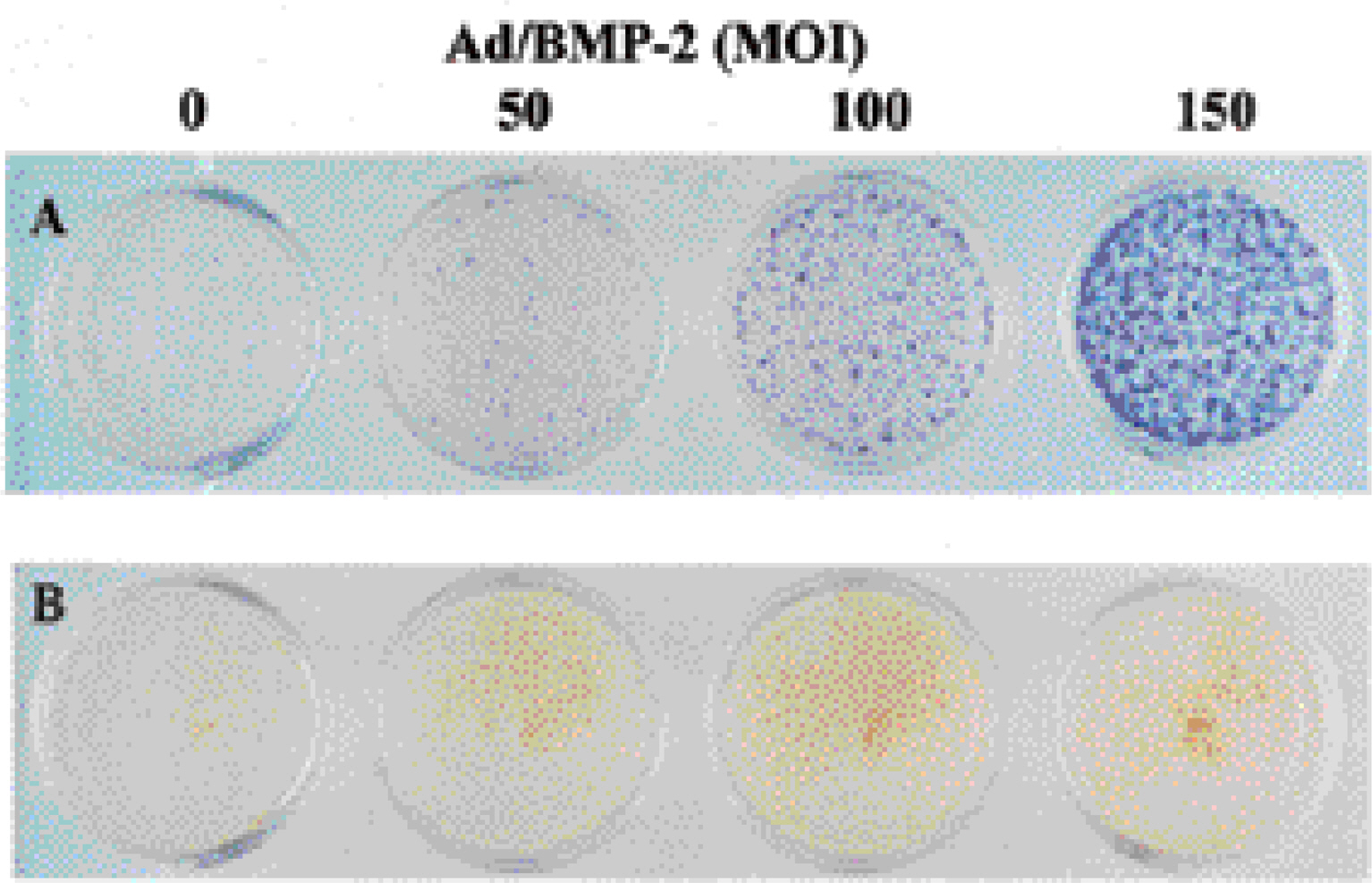J Korean Soc Spine Surg.
2003 Mar;10(1):1-7. 10.4184/jkss.2003.10.1.1.
Dual Roles of Ligamentum Flavum for Spinal Fusion: As an Osteoinductive Agent and Carrier for Ex-vivo Gene Transfer
- Affiliations
-
- 1Department of Orthopedic Surgery, Yonsei University, College of Medicine, Seoul, Korea. hwanlee@yumc.yonsei.ac.kr
- KMID: 2209698
- DOI: http://doi.org/10.4184/jkss.2003.10.1.1
Abstract
- STUDY DESIGN: An in-vitro experiment using human ligamentum flavum (LF) and the adnovirus-BMP-2 construct, Ad/BMP-2.
OBJECTIVES
To determine the dual roles of LF as an osteoinductive agent and carrier for ex-vivo gene transfer. SUMMARY OF LITERATURE REVIEW: LF is known to have osteogenic potential. Pathologically, ossified LF may cause myelopathy and radiculopathy. BMP-2 is known as an important factor in the differentiation, and maintenance, of osteoblast phenotypes. Ex-vivo gene transfer, using human LF for spinal fusion, has never been attempted before. MATERIALS AND METHODS: The LF cells were cultured from the degenerated LF of spinal stenosis patients. An adenovirus construct, containing BMP-2 cDNA (Ad/BMP-2), was also produced. The LF cell cultures were exposed to the adenoviral construct. The Osteocalcin expression was analysed by Western blot analysis. The osteocalcin and BMP-2 mRNA expressions were analysed by RT-PCR. Bone formation was assessed by alkaline phosphatase and Von Kossa stains.
RESULTS
The LF cell cultures, with Ad/BMP-2, showed transgene expression in the Western blot analysis. Also, the cultures exhibited the mRNA expressions of both osteocalcin and BMP-2, in a dose-dependent manner. The LF cultures, with Ad/BMP-2, demonstrated alkaline phosphatase expression and bone nodule formations from the Von Kossa staining.
CONCLUSION
The genetically modified LF strongly induced osteogenesis, which can be used during a spinal fusion, as an osteoinductive agent and carrier, for ex-vivo gene transfer.
Keyword
MeSH Terms
-
Adenoviridae
Alkaline Phosphatase
Blotting, Western
Cell Culture Techniques
Coloring Agents
DNA, Complementary
Humans
Ligamentum Flavum*
Osteoblasts
Osteocalcin
Osteogenesis
Phenotype
Radiculopathy
RNA, Messenger
Spinal Cord Diseases
Spinal Fusion*
Spinal Stenosis
Transgenes
Alkaline Phosphatase
Coloring Agents
DNA, Complementary
Osteocalcin
RNA, Messenger
Figure
Reference
-
1). Hayashi K., Ishidou Y., Yonemori K. Expression and localization of bone morphogenetic proteins (BMPs) and BMP receptors in ossification of the ligamentum flavum. Bone,. 21:23–30. 1997.
Article2). Hoshi K., Amizuka N., Sakou T., Kurokawa T., Ozawa H. Fibroblasts of spinal ligaments pathologically differentiate into chondrocytes induced by recombinant human bone morphogenetic protein-2: morphological examinations for ossification of spinal ligaments. Bone,. 21:155–62. 1997.
Article3). Israel DI., Nove J., Kerns KM., Moutsatsos IK., Kaufman RJ. Expression and characterization of bone morphogenetic protein-2 in Chinese hamster ovary cells. Growth Factors,. 7:139–50. 1992.
Article4). Mimatsu K., Kishi S., and Hashizume Y. Experimental chronic compression on the spinal cord of the rabbit by ectopic bone formation in the ligamentum flavum with bone morphogenetic protein. Spinal Cord,. 35:740–6. 1997.
Article5). Moon SH., Kim H., Kwon EH., Won JH., Kim HS., Hahn SB, et al. Osteogenesis by transfer of bone morphogenetic protein-2 cDNA in ligamentum flavum cells: Approach toward tissue engineering. J Kor Spine Surg,. 9:263–269. 2002.
Article6). Saito H., Mimatsu K., Sato K., Hashizume Y. Histopathologic and morphometric study of spinal cord lesion in a chronic cord compression model using bone morphogenetic protein in rabbits. Spine,. 17:1368–74. 1992.
Article7). Specchia N., Pagnotta A., Gigante A., Logroscino G., and Toesca A. Characterization of cultured human ligamnet flavum cells in lumbar spine stenosis. J Orthop Res,. 19:294–300. 2001.8). Takuwa Y., Ohse C., Wang EA., Wozney JM., Yamashita K. Bone morphogenetic protein-2 stimulates alkaline phosphatase activity and collagen synthesis in cultured osteoblastic cells, MC3T3-E1. Biochem Biophys Res Commun,. 174:96–101. 1991.
Article9). Viggeswarapu M., Boden SD., Liu Y., Hair GA., Louis-Ugbo J., Murakami H, et al. Adenoviral delivery of LIM mineralization protein-1 induces new-bone formation in vitro and in vivo. J Bone Joint Surg Am,. 83-A:364–76. 2001.
Article10). Wang EA., Rosen V., Cordes P., Hewick RM., Kriz MJ., Luxenberg DP, et al. Purification and characterization of other distinct bone-inducing factors. Proc Natl Acad Sci U S A,. 85:9484–8. 1988.
Article11). Wang EA., Rosen V., D'Alessandro JS., Bauduy M., Cordes P., Harada T, et al. Recombinant human bone morphogenetic protein induces bone formation. Proc Natl Acad Sci U S A,. 87:2220–4. 1990.
Article12). Yoshida M., Shima K., Taniguchi Y., Tamaki T., Tanaka T. Hypertrophied ligamentum flavum in lumbar spinal canal stenosis. Spine,. 17:1353–60. 1992.
Article13). Young BH., Peng H., and Huard J. Muscle-based gene therapy and tissue engineering to improve bone healing. Clin Orthop,. 403:S243–51. 2002.
Article
- Full Text Links
- Actions
-
Cited
- CITED
-
- Close
- Share
- Similar articles
-
- Thoracic Myelopathy Due to Ossification of Ligamentum Flavum: Three cases Report
- Osteogenesis by Transfer of Bone Morphogenetic Protein-2 cDNA in Ligamentum Flavum Cells: Approach Toward Tissue Engineering
- Focal Ligamentum Flavum Hypertrophy with Ochronotic Deposits: An Unusual Cause for Neurogenic Claudication in Alkaptonuria
- Immunohistochemical Study of the Ligamentum Flavum in the Lumbar Spinal Stenosis
- Ligamentum Flavum Hematoma in the Adjacent Segment after a long Level Fusion




